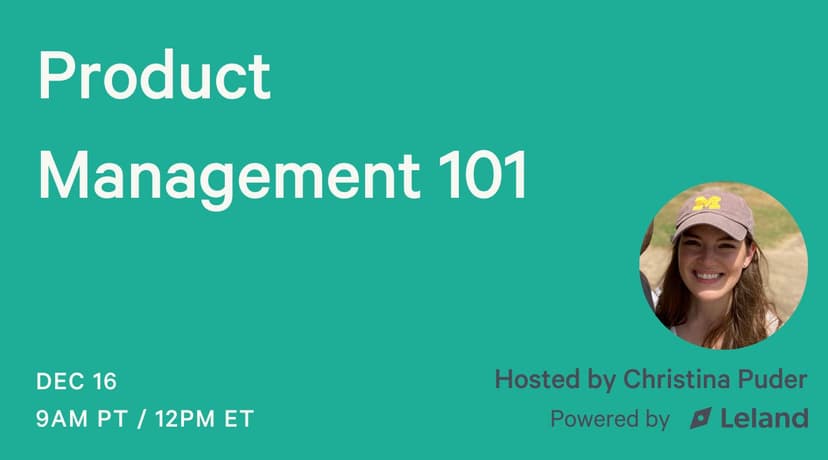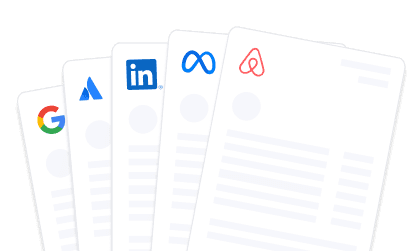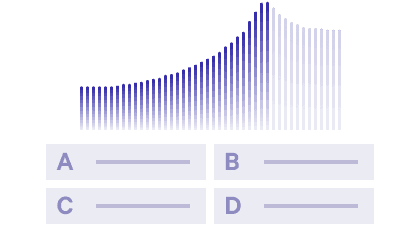Google Product Manager Interview: Process, Questions, & Tips (2025)
Get ready for your Google product manager interview with our step-by-step guide! Learn about the process, top questions, and expert tips to help you land the job.
Posted September 10, 2025

Join a free event
Learn from top coaches and industry experts in live, interactive sessions you can join for free.
Table of Contents
If you're aiming for a Google Product Manager (PM) position, you’re not alone. Thousands of applicants around the world aspire to secure a PM role at Google since it is one of the biggest and most successful tech companies. But what does the Google product manager interview process look like? How can you prepare effectively to stand out among successful candidates?
This guide breaks down the entire interview process, from the initial recruiter screen to the final on-site interview, and shares tips on tackling common PM interview questions.
Read: An Overview of the Different Roles in Product Management
Understanding the Google PM Interview Process
Recruiter Screen
The first step in the Google PM interview process is usually a recruiter screen. This is an initial conversation with a Google recruiter, where you’ll discuss your background, experience, and motivations for applying to Google. The recruiter’s job is to determine whether you have the right skillset for a product manager position at Google.
What to Expect
Expect behavioral questions about your past experiences and previous work. They will ask for an overview of your technical background, even if you don't have a computer science degree. You'll also discuss how your goals align with Google’s company culture and product development strategy. What you need to do is review your cover letter and resume to be ready to discuss your past projects in detail and be prepared to answer questions about user empathy and your motivation for working at such a large company.
Phone Interview
Once you pass the recruiter screen, you’ll move on to the phone interview. This stage typically lasts about 45 minutes and is usually your first technical interview. During the phone interview, Google interviewers will evaluate your product management knowledge and how you approach different types of problems.
Onsite Interview
The onsite interview is the most comprehensive stage of the interview process. This is where you’ll meet with multiple interviewers, including PMs, engineers, and sometimes a hiring committee. The onsite interview typically lasts about 4-5 hours and includes multiple rounds. Expect a product design, behavioral, analytical, and system design questions: “How would you improve a Google product?” Here are the types of questions you might get:
Behavioral questions: These assess your ability to work cross-functionally with teams such as the engineering team and to manage challenges.
Analytical questions: For example, "Estimate the number of Google Cloud users in the San Francisco area."
System design questions: "Design a system for self-driving cars." These questions will assess your technical thinking and problem-solving skills.
To prepare, review the product roadmap of various Google products and familiarize yourself with the types of problems Google is solving. You can also practice answering both technical questions and execution questions with a focus on clarity and simplicity. And lastly, understand user problems and user needs, and learn how to incorporate that empathy into product solutions.
Team Matching
After the onsite interviews, team matching will take place. Google may match you with a team based on your strengths and the areas where they need a PM. If you’ve done well, Google will reach out with specific teams and roles they think are a good fit for you.
Note: Be flexible and open to discussing various Google PMs and teams. Show interest in Google’s culture and why you’re excited to work on specific products.
Hiring Committee
The final step of the interview process is the hiring committee. This group of senior leaders and recruiters reviews feedback from all interviewers and makes the final decision. The hiring committee will consider feedback from all your interviews and assess how you fit with the Google product vision and company culture. So make sure to leave a strong impression in every interview. Google looks for candidates who are not only skilled but also a good fit for their culture and teamwork.
Common Google PM Interview Questions and How to Answer Them
Product Design Questions
Example Question: "How would you improve Google search?"
Sample Answer: To improve Google Search, I would first define the problem. Users often struggle to find the most relevant results, especially for niche queries. Analyzing user pain points, I’d focus on issues like irrelevant results and difficulty refining searches. My solution would be to enhance AI's understanding of user intent and introduce more dynamic filters to allow users to easily narrow results based on their needs. This would improve relevance and speed, delivering a more personalized search experience.
Note: Walk through the product design process: Define the problem, analyze user pain points, and propose a solution.
Estimation Questions
Example Question: "How would you estimate the number of Google Cloud users in San Francisco?"
Sample Answer: To estimate the number of Google Cloud users in San Francisco, I’d start by estimating the city’s population, around 900,000. Then, I’d assume that 20% of businesses use Google Cloud. Based on the number of businesses in the area, it may be 10,000 businesses using the service.
Note: Break down the problem: start by estimating the total population of San Francisco, then calculate the potential market for Google Cloud based on logical assumptions.
Google Behavioral Questions
Example Question: "Tell me about a time when you worked with an engineering team to solve a product issue."
Sample Answer: In my previous role, a new feature was causing slowdowns in our product. I worked with the engineering team to identify the issue, which was an inefficient API call. We prioritized the fix and implemented a solution, and reduced customer complaints.
Note: Use the STAR method (Situation, Task, Action, Result) to describe the challenge and how you collaborated with the team.
Technical Questions
Example Question: "Explain the system design for self-driving cars."
Sample Answer: "The system design for self-driving cars includes components like sensors (cameras, LiDAR, radar) to detect the environment and make decisions for path planning. It also requires a machine learning model to improve decision-making over time and a safety system to ensure the car can handle emergencies and maintain safety standards."
Note: Break down the components of the product, including sensors, data collection, and decision-making algorithms.
Execution Questions
Example Question: "How would you prioritize a new feature for Google Cloud?"
Sample Answer: To prioritize a new feature for Google Cloud, I will first assess market demand to ensure there is a clear need. Then, I’ll align it with the company's strategy to ensure it supports long-term goals. Lastly, I will evaluate user feedback and technical feasibility to ensure it addresses user pain points and can be implemented effectively.
Note: Consider factors such as market demand, company strategy, user feedback, and technical feasibility to prioritize features.
Read: Product Execution Interview Guide
What Google Looks for in PM Candidates
Skills and Expertise
Google looks for candidates who have a deep understanding of product management. This includes a focus on data-driven decision-making and the ability to lead cross-functional teams. As a Google product manager, you must be able to balance short-term goals with long-term strategy.
Read: The 20 Most Important Product Manager Skills
Behavioral Traits
Google also values cultural fit and user empathy. The company places great importance on working well with others, especially with Google interviewers, and having a good understanding of what are the needs of the users.
How to Prepare for the Google PM Interview
Master PM Interview Frameworks
One of the best ways to approach the PM interview questions is by using frameworks like CIRCLES for product design questions. This framework helps break down the problem into manageable parts and ensures you stay focused on user needs and market fit. This means:
- C – Comprehend the situation: Understand the problem at hand and the context surrounding it.
- I – Identify the customer: Determine who the end-users are and what their needs are.
- R – Requirements: Clarify the key functional and non-functional requirements for the product or feature.
- C – Create solutions: Brainstorm possible solutions to the problem, keeping user needs in mind.
- L – List alternatives: Identify and evaluate different alternatives to the proposed solution.
- E – Evaluate trade-offs: Assess the pros and cons of each solution, considering factors like feasibility, cost, and impact.
- S – Summarize the solution: Conclude with the best solution, explaining why it's the most effective approach.
Mock Interviews
Practicing with peer mock interviews is a great way to prepare for your interview. It helps you get used to answering PM interview questions on the spot and improves your thinking process.
Read: How to Prepare for Google Product Management Case Interviews
Study Google’s Products
Understanding Google products is important. Google values candidates who have firsthand insights into their offerings and the impact those products have on users. Study products like Google search, Google Cloud, and Google Maps to prepare for specific questions related to these services.
Read: How to Prepare for Google Product Sense Interviews
5 Expert Tips on How to Ace Your Google Interview
1. Master the "CIRCLES" Product Design Framework
One of the most common types of questions in a Google PM interview is related to product design. To excel in this area, learn and practice the CIRCLES framework: Comprehend the situation, Identify the customer, Requirements, Create solutions, List alternatives, Evaluate trade-offs, and Summarize the solution. This framework helps you structure your thinking and deliver clear, logical responses.
2. Provide Data-Driven Responses, Even for Behavioral Questions
Google values data-driven decision-making across all areas of product management. For behavioral questions, always tie your answers back to measurable outcomes. This will demonstrate both your ability to track and analyze metrics and your results-driven mindset, which is critical in any Google product manager role.
3. Think in Systems for Technical and Execution Questions
When you encounter technical questions or execution questions like “How would you improve Google Cloud?”, adopt a systems-thinking approach. Break down the problem into smaller subsystems, like infrastructure, user interface, and scalability. For instance, if asked about a system design for self-driving cars, think about the sensor network, data processing layer, and decision-making algorithms. This approach shows you can see the bigger picture and also get into the specifics.
4. Show Your Understanding of Google's "10x" Culture
Google hires for "10x engineers" and 10x product managers. People who aren’t just good but transformational. In your answers, subtly weave in the mindset of going beyond incremental improvements. When asked how you’d approach a challenge, focus on innovative, scalable solutions that could impact millions of users, not just small tweaks. Show that you understand the scale at which Google operates and can think big.
5. Prepare for "Googleyness" with Real Examples of Cultural Fit
Google places significant emphasis on cultural fit during the interview process. To demonstrate if you fit in their culture, prepare examples that show how you collaborate with diverse teams, approach complex problem-solving, and how you’ve navigate ambiguity in previous roles. Be ready to explain how you align with Google’s core values, like “focus on the user” and “fail fast, learn faster.” These real-world examples will make you stand out as a candidate who not only has the technical and management skills but also embodies Google’s unique approach to product development.
The Bottom Line
Securing a Google product manager position is no easy feat. The process is rigorous, and competition is fierce. But with thorough preparation, you can navigate your PM interview with confidence. Remember to stay focused on user needs, data-driven decisions, and your ability to collaborate with Google interviewers to solve complex problems.
Ready to take the next step?
Start practicing for your Google PM interview with mock sessions, research, and expert insights with the help of our expert coaches! Keep building your skills, and you could soon land your dream job at Google.
To broaden your knowledge, you can also read these:
- What is Product Management?
- Product Manager Resume: The Ultimate Guide (With Examples & Template)
- Is a Product Manager Certification from Google Worth It?
- Metrics for Product Managers: What to Measure and How to Interpret Results
- Microsoft Product Manager: Interview Process, Salary, & Responsibilities
- Product Sense: What it Is & How to Develop It
- Product Strategy: What it Is and How to Build One
FAQs
How to prepare for a Google PM interview?
- Focus on mastering frameworks like CIRCLES for product design, practicing behavioral questions, and understanding Google’s products and culture.
What is the acceptance rate for Google PM?
- The acceptance rate for Google PMs is highly competitive, often below 1%, with thousands of applicants vying for limited positions.
Is cracking the PM interview still relevant?
- Yes, cracking the PM interview is still highly relevant as Google continues to value problem-solving, product design skills, and cultural fit.
How to prepare for a Google PM interview?
- Study Google’s products, practice using interview frameworks, and be ready to discuss your past work with a focus on results and user impact.
How many rounds of interviews for a Google product manager?
- Google’s PM interview typically includes 4–5 rounds: recruiter screen, phone interview, onsite interviews, and team matching.
What is the rule of 4 in Google interviews?
- The "Rule of 4" refers to Google’s practice of having at least four interviewers assess a candidate across different areas to ensure a thorough evaluation.
Browse hundreds of expert coaches
Leland coaches have helped thousands of people achieve their goals. A dedicated mentor can make all the difference.

























